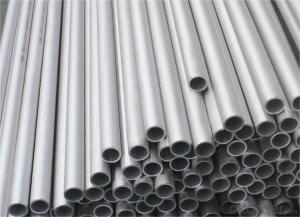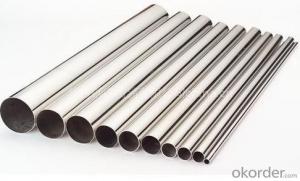Heat Exchanger Stainless Steel Pipe TP316 ASTM A213
- Loading Port:
- Ningbo
- Payment Terms:
- TT OR LC
- Min Order Qty:
- 1 m.t.
- Supply Capability:
- 5000 m.t./month
OKorder Service Pledge
OKorder Financial Service
You Might Also Like
1、Structure of Heat Exchanger Stainless Steel Pipe TP316 ASTM A213 Description:
Stainless Steel are corrosion resistant and can be built to meet various industrial, pharmaceutical, food, dairy, and beverage requirements. Other material and alloys including (Hastelloy, AL-6XN), titanium, copper-nickel alloys, copper, steel, carbon steel and brass are also available.
2、Main Features of Heat Exchanger Stainless Steel Pipe TP316 ASTM A213:
• High manufacturing accuracy
• High strength
• Small inertia resistance
• Strong heat dissipation ability
• Good visual effect
•Reasonable price
3、Heat Exchanger Stainless Steel Pipe TP316 ASTM A213 Images:
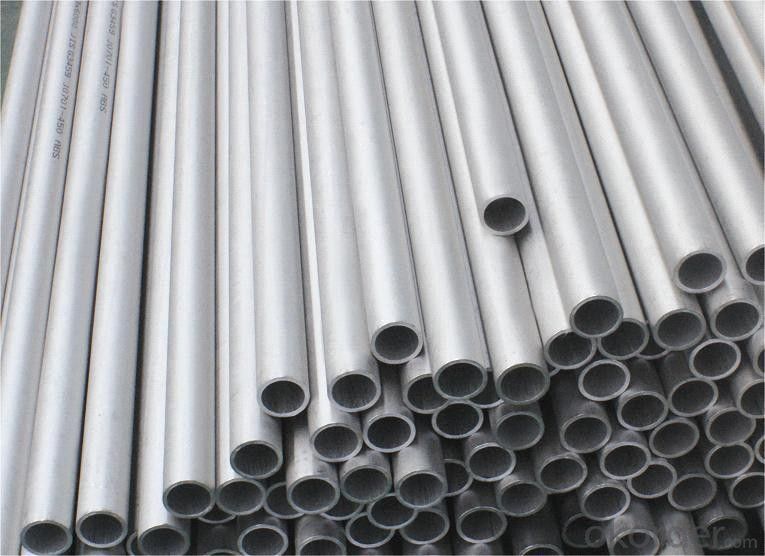
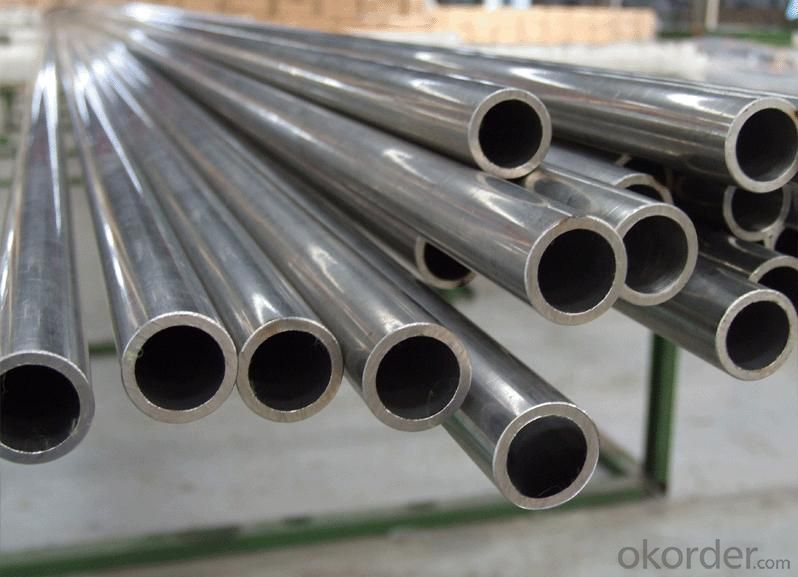
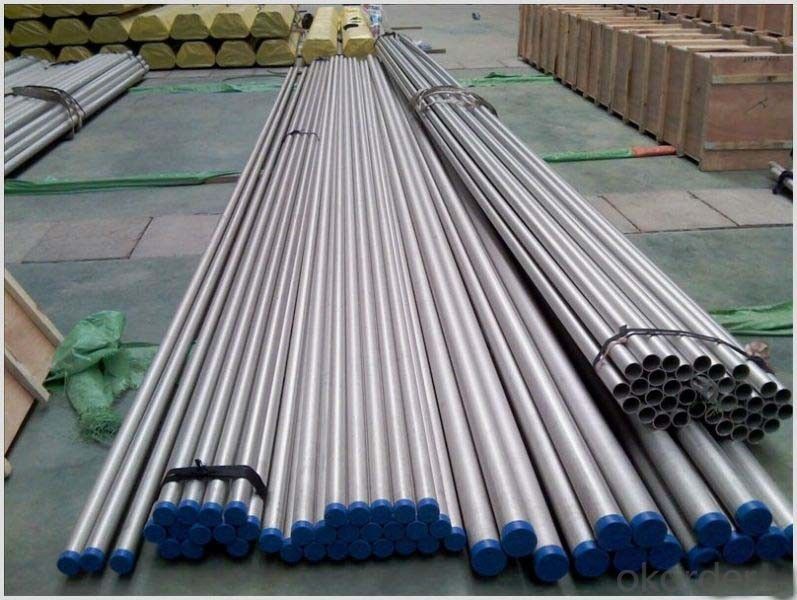
4、Heat Exchanger Stainless Steel Pipe TP316 ASTM A213 Specification:
| Welded Stainless Steel Tube | |
| Material Grade | 304,304L,316 ,316L,321,310S,2205,904and so on. |
| Standard | ASTM A312, A554, A249, A269 and A270,ect |
| DIN 17456-85 , DIN 17458-85, DIN 17459-92,ect | |
| JIS G3446-1994, JIS G3448-1997, JIS G3459-1997, JIS G3463-1994,ect | |
| GB13296-1991, GB14975-2002, GB14976-2002,ect | |
| Outer Diameter | 13.7-2020mm |
| Thickness | 0.5-50mm |
| Length | 1m -12m or as customers' request |
| Polish | 180G, 320G, 400G Satin / Hairline |
| 400G, 500G, 600G or 800G Mirror finish | |
| Test | eddy current inspection, ultrasonic inspection, X-ray inspection, real-time imaging, hydrostatic test, spectral analysis, intergranular corrosion, water pressure test, and mechanical property testing facilities. |
| Payment | 1) by L/C at sight, |
| 2) 30% deposit, 70% balance before Shipping. | |
| Delivery time | 7 days if this goods is stock goods. |
| 25 days if this goods will be produced after order | |
| Validity | Valid time is 3 days for price usually. |
| Payment terms | FOB QINGDAO |
| MOQ | 1 ton |
| Capacity | 1000 ton per month |
| Certificate | ISO, SGS, and third part inspection |
| Applications | the products are widely used in chemical industry, condenser pipe, heat exchanger, petroleum, shipping military, environment protection, high temperature resistant, low temperature resistant, corrosion resistant and so on. |
| packing details | 1) Wooden-box Package 2) The Wooden Frame Packing. 3) Intertexture Cloth Packaging with the Iron Sheet Bonding and the Two Terminals Covered With Plastic Dome. |
5、FAQ of Heat Exchanger Stainless Steel Pipe TP316 ASTM A213:
①How is the quality of your products?
Our products are manufactured strictly according to national and internaional standard, and we take a test on every pipe before delivered out. If you want see our quality certifications and all kinds of testing report, please just ask us for it.
Guaranteed: If products’ quality don’t accord to discription as we give or the promise before you place order, we promise 100% refund.
②How about price?
Yes, we are factory and be able to give you lowest price below market one, and we have a policy that “ for saving time and absolutely honest business attitude, we quote as lowest as possible for any customer, and discount can be given according to quantity”,if you like bargain and factory price is not low enough as you think, just don’t waste your time.Please trust the quotation we would give you, it is professional one.
③Why should you chose us?
Chose happens because of quality, then price, We can give you both.Additionally, we can also offer professional products inquiry, products knowledge train(for agents), smooth goods delivery, exellent customer solution proposals.Our service formula: good quality+good price+good service=customer’s trust
SGS test is available, customer inspection before shipping is welcome, third party inspection is no problem.
Any question, pls feel free to contact us !
- Q:What is the difference between 17-4PH and 15-5PH stainless steel pipes?
- The main difference between 17-4PH and 15-5PH stainless steel pipes lies in their chemical compositions and mechanical properties. 17-4PH stainless steel contains about 17% chromium, 4% nickel, and 4% copper. It also includes small amounts of molybdenum and niobium. This composition gives it excellent corrosion resistance, high strength, and good toughness. It is commonly used in applications that require high strength, such as aerospace components, oil and gas equipment, and marine applications. On the other hand, 15-5PH stainless steel contains about 15% chromium, 5% nickel, and 3% copper. It also includes small amounts of molybdenum and niobium. This composition provides good corrosion resistance, high strength, and excellent toughness. It is often used in applications that require a combination of strength and corrosion resistance, such as valves, pumps, and shafts. In summary, while both 17-4PH and 15-5PH stainless steel pipes have similar corrosion resistance and high strength, their specific compositions and properties may make them more suitable for different applications.
- Q:Are stainless steel pipes resistant to caustic solutions?
- Yes, stainless steel pipes are generally resistant to caustic solutions. Stainless steel is known for its excellent corrosion resistance, which makes it a preferred material for various applications in industries that deal with corrosive substances, including caustic solutions. The high chromium content in stainless steel forms a protective layer on the surface of the pipe, preventing it from reacting with caustic solutions and other corrosive materials. However, it is important to note that the resistance of stainless steel pipes can vary depending on the specific grade and composition of the stainless steel being used. Therefore, it is advisable to consult with a professional or refer to the specific stainless steel grade's corrosion resistance properties to ensure its suitability for the intended application with caustic solutions.
- Q:Can stainless steel pipes be used for sewage disposal?
- Yes, stainless steel pipes can be used for sewage disposal. Stainless steel is highly resistant to corrosion, making it a suitable material for sewage pipes that are exposed to various chemicals and moisture. Additionally, stainless steel pipes have smooth surfaces, which helps prevent the buildup of debris and facilitates the flow of sewage.
- Q:Are stainless steel pipes resistant to stress corrosion cracking?
- Yes, stainless steel pipes are highly resistant to stress corrosion cracking due to their inherent corrosion resistance properties.
- Q:What is the difference between seamless and high-frequency welded stainless steel pipes?
- Seamless and high-frequency welded stainless steel pipes are two different types of pipes used in various applications. Seamless stainless steel pipes are manufactured through a process called seamless pipe manufacturing, where a solid billet is heated and pierced to form a hollow tube. This process ensures that there are no seams or joints in the pipe, making it ideal for applications that require high pressure, high temperature, or corrosive environments. Seamless pipes offer superior strength and reliability due to their uniform composition and absence of welding. On the other hand, high-frequency welded stainless steel pipes are manufactured using a different process known as high-frequency welding. This process involves passing a flat strip of stainless steel through a series of rollers to form a tube shape. The edges of the strip are then heated using high-frequency electrical currents and fused together to create a solid pipe. The resulting pipe has a visible welded seam along its length. While both seamless and high-frequency welded stainless steel pipes are made from stainless steel, there are some differences between them. One major difference is the manufacturing process. Seamless pipes are made without any welding, resulting in a pipe with no seams or joints. High-frequency welded pipes, on the other hand, have a visible welded seam along their length. Another difference is in their strength and reliability. Seamless pipes have a more uniform composition and absence of welding, which gives them higher strength and reliability compared to high-frequency welded pipes. This makes seamless pipes more suitable for applications that require high pressure, high temperature, or corrosive environments. Additionally, the production cost of seamless pipes is generally higher than that of high-frequency welded pipes. The seamless pipe manufacturing process requires more complex machinery and additional steps, leading to higher production costs. High-frequency welded pipes, on the other hand, involve a simpler and more cost-effective manufacturing process. In summary, the main difference between seamless and high-frequency welded stainless steel pipes lies in their manufacturing process, strength, and cost. Seamless pipes are made without any welding, offering higher strength and reliability, but at a higher cost. High-frequency welded pipes have a visible welded seam but are more cost-effective. The choice between the two types of pipes depends on the specific requirements of the application and the budget available.
- Q:What's the difference between stainless steel pipe and stainless steel composite pipe?
- Stainless steel is also divided into several kinds of 200201300301304,The market is generally 301 material, 304 of the best results, followed by 301.
- Q:What is the maximum pressure rating for stainless steel pipes?
- The maximum pressure rating for stainless steel pipes can vary depending on several factors such as the grade of stainless steel, the diameter and wall thickness of the pipe, and the specific application or industry requirements. However, stainless steel pipes are known for their high strength and corrosion resistance, making them suitable for high-pressure applications. In general, stainless steel pipes can have maximum pressure ratings ranging from a few hundred psi (pounds per square inch) to several thousand psi. It is crucial to consult the appropriate industry standards, codes, and specifications or consult with a qualified engineer or manufacturer to determine the specific maximum pressure rating for a particular stainless steel pipe in a given application.
- Q:What are the factors to consider when selecting a stainless steel pipe for a specific application?
- When selecting a stainless steel pipe for a specific application, there are several factors to consider. These factors include the required corrosion resistance, temperature and pressure requirements, the type of fluid or gas being transported, the pipe size and thickness, the desired strength and durability, and any specific industry standards or regulations that need to be followed. Additionally, the cost, availability, and ease of installation should also be taken into account. Overall, it is important to carefully evaluate these factors to ensure that the chosen stainless steel pipe is suitable for the intended application.
- Q:Can stainless steel pipes be used for wastewater pumping stations?
- Yes, stainless steel pipes can be used for wastewater pumping stations. Stainless steel pipes are known for their durability, corrosion resistance, and long lifespan, making them an excellent choice for wastewater applications. Wastewater pumping stations often deal with corrosive and abrasive fluids, and stainless steel pipes are capable of withstanding these harsh conditions without deteriorating or causing contamination. Additionally, stainless steel pipes are easy to clean and maintain, which is crucial for wastewater systems. Overall, stainless steel pipes are a reliable and suitable option for wastewater pumping stations.
- Q:What is the maximum diameter for a stainless steel pipe?
- The maximum diameter of a stainless steel pipe can differ based on different factors including the manufacturing process, grade of stainless steel, and intended use. Nevertheless, in general, stainless steel pipes can be produced in a diverse range of diameters to accommodate various industrial and commercial requirements. The maximum diameter can span from a few millimeters for precise, small pipes utilized in industries like medical and instrumentation, to several meters for extensive pipes used in applications like oil and gas pipelines or industrial infrastructure. It is advisable to seek guidance from a reliable manufacturer or supplier to ascertain the particular maximum diameter offered for the desired stainless steel pipe.
1. Manufacturer Overview |
|
|---|---|
| Location | |
| Year Established | |
| Annual Output Value | |
| Main Markets | |
| Company Certifications | |
2. Manufacturer Certificates |
|
|---|---|
| a) Certification Name | |
| Range | |
| Reference | |
| Validity Period | |
3. Manufacturer Capability |
|
|---|---|
| a)Trade Capacity | |
| Nearest Port | |
| Export Percentage | |
| No.of Employees in Trade Department | |
| Language Spoken: | |
| b)Factory Information | |
| Factory Size: | |
| No. of Production Lines | |
| Contract Manufacturing | |
| Product Price Range | |
Send your message to us
Heat Exchanger Stainless Steel Pipe TP316 ASTM A213
- Loading Port:
- Ningbo
- Payment Terms:
- TT OR LC
- Min Order Qty:
- 1 m.t.
- Supply Capability:
- 5000 m.t./month
OKorder Service Pledge
OKorder Financial Service
Similar products
New products
Hot products
Related keywords

